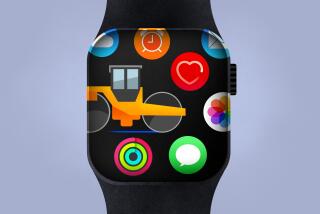TURMOIL AT APPLE : A New Leader
- Share via
Apple Computer Inc. saw tremendous growth in the late 1970s and 1980s but then watched its fortunes fall as it battled price competition and struggled to compete in a Microsoft-dominated computer world. The company has historically been plagued by management problems and infighting. On Friday Apple announced it was naming Gilbert F. Amelio as chairman and chief executive. A look at Apple’s tumultuous history:
1976: College dropouts Steve Jobs, then 21, and Steve Wozniak, then 26, raise $1,300 by selling a van and two calculators and launch the company.
1977: Armas C. “Mike” Markkula Jr. buys a third of Apple for $250,000. The firm essentially invents the personal computer industry with the release of the Apple II, which has $1 million in annualized sales by June.
1980: The company goes public. Its offering of 4.6 million shares at $22 each sells out within minutes.
1983: Apple releases Lisa, which features a mouse and a hand-controlled pointer. Lisa’s sales go badly and Apple’s stock price plummets. Jobs brings in John Sculley as president.
1984: The Macintosh, which Jobs envisioned as “the people’s computer,” is introduced. It incorporates key elements of the Lisa and features a revolutionary graphical interface. Apple airs its legendary “1984” advertisement during the Super Bowl, and sells 70,000 Macs in the first 100 days.
1985: With Mac sales stagnating and the company wracked by infighting, Sculley ousts Jobs in a dramatic boardroom coup.
1990: Apple’s revenue soars from less than $2 billion in 1986 to more than $5.5 billion and profit reaches a record $474 million. But the good times pass quickly.
1991: With profit and market share sliding, Apple lays off 10% of its work force, introduces low-cost Macs and negotiates an alliance with IBM Corp.
1993: Apple’s board ousts Sculley for not paying enough attention to day-to-day operations, and installs Michael Spindler, a company veteran and onetime head of Apple Europe, as chief executive. Markkula later reassumes the chairman’s post, which had also been held by Sculley.
1995: A wave of executive departures and poor forecasting of demand leave Apple in disarray even as the PC market booms. Criticism of Spindler mounts.
January, 1996: Apple announces the layoff of 1,300 employees, but analysts view the restructuring effort as a weak half-measure. The Wall Street Journal says Apple will merge with Sun Microsystems, but no deal is forthcoming.
Feb. 2, 1996: Apple names board member Gilbert F. Amelio as chairman and chief executive. Spindler is off Apple’s board, but Markkula will stay on as Apple’s vice chairman. Amelio resigned as chairman of National Semiconductor earlier in the day.
Profile: Gilbert F. Amelio
Age: 52
Residence: Los Altos, Calif.
Education: Bachelor’s, master’s and doctorate degrees in physics from Georgia Institute of Technology.
Career highlights: Amelio described the revival of National Semiconductor, the fifth-largest, U.S.-based computer chip manufacturer, in a 1995 book he co-wrote called “Profit From Experience.” National was near bankruptcy when Amelio, who had also lifted Rockwell International back into profitability, took over in 1991 as president and chief executive. He was named chairman in 1995. Amelio was appointed to Apple’s board in 1994. He was president of communication systems at Rockwell from 1988 to 1991 and president of the semiconductor products division from 1983 to 1988. He designed microprocessors at Fairchild Semiconductor from 1971 to 1983. Amelio was a member of the technical staff at Bell Telephone Labs from 1968 to 1971.
Sources: International Directory of Company Histories, Times reports.
Researched by JENNIFER OLDHAM / Los Angeles Times






